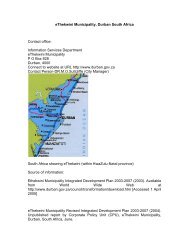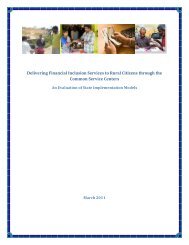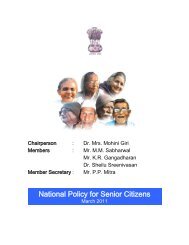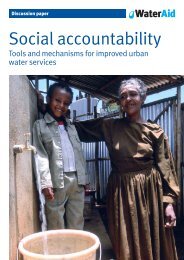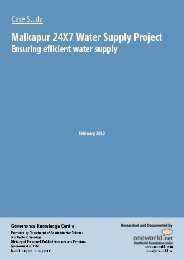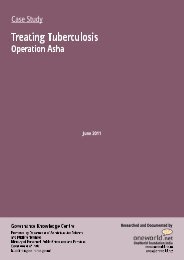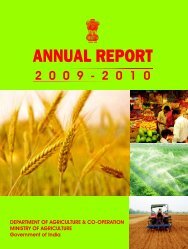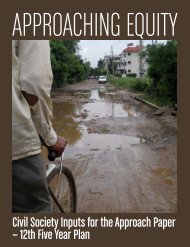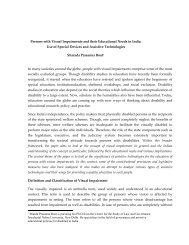Changing Framework of Local Governance and - Create
Changing Framework of Local Governance and - Create
Changing Framework of Local Governance and - Create
You also want an ePaper? Increase the reach of your titles
YUMPU automatically turns print PDFs into web optimized ePapers that Google loves.
<strong>Changing</strong> <strong>Framework</strong> <strong>of</strong> <strong>Local</strong> <strong>Governance</strong> <strong>and</strong> Community Participation in Elementary Educationin enrolments. Education Guarantee Scheme centres which were initially based on voluntarycommunity initiatives, enrolled 1.233 million children <strong>of</strong> which, 47% were girls, <strong>and</strong> tribalchildren accounted for around 45% (GoMP, 2003:22). The Maa-Beti Melas (mother-daughterfairs) in Madhya Pradesh focus on an awareness generation among parents through motivationcamps organized for mobilizing out-<strong>of</strong>-school girls <strong>and</strong> their mothers. It also includes door-todoorcontacts <strong>and</strong> orientation <strong>of</strong> PTA members. A recent publication by SIEMAT Keralareports that local government is now investing resources <strong>and</strong> providing leadership inconducting several activities for achieving ‘sustainable excellence through effectiveeducational governance’ (GoK, 2009:75). Panchayats are involved in conducting annualfestivals <strong>of</strong> schools to promote family / social get togethers, film camps <strong>and</strong> music clubs todevelop creativity among students. Panchayats are also engaged in improving learning skills<strong>of</strong> English <strong>and</strong> computer education in many districts for which they have provided resources<strong>and</strong> even developed learning materials including text books in collaboration with DIETs(GoK, 2009:75-92).As previously mentioned panchayati raj Institutions are involved in providing primary <strong>and</strong>secondary education through Shishu Shiksha Karmasuchi programme (SSKs) <strong>and</strong> MadhyamikSikhsa Kendras (MSKs) 34 in West Bengal for children unable to benefit from regular schools.Initially the programme was a state / Government sponsored programme which was subsequentlylinked to SSA as its EGS/AIE component (GoWB, 2007:4). Community participation asmentioned by PBRSSM (Pashim Banga Rajya Sishu Siksha Mission) Annual Report ‘isconsidered as driving force <strong>of</strong> the Karma Suchi’ (GoWB, 2007:4). These centres are managed bya managing committee which serves as an elected representative body <strong>of</strong> the parents <strong>and</strong> thecommunity. They are responsible for the opening <strong>of</strong> Sishu Siksha <strong>and</strong> Madhyamik SikshaKendras, engagement <strong>of</strong> Sahayikas (teachers in SSK) <strong>and</strong> Samprasaraks (teachers in MSK), theconstruction <strong>of</strong> buildings, identification <strong>of</strong> children, their enrolment <strong>and</strong> retention, disbursement<strong>of</strong> honorarium, maintaining account etc. Managing Committee members have already beentrained (GoWB, 2007:8) <strong>and</strong> training modules have been prepared for this purpose.Learners in these SSKs are provided with hot cooked mid-day meal for which members <strong>of</strong> SelfHelp Groups are engaged. Panchayats construct kitchen sheds for cooking the meals <strong>and</strong> in manycases the members <strong>of</strong> the management committees <strong>and</strong> guardians raise resources to add to thequality <strong>of</strong> food served. The state has introduced several mechanisms <strong>and</strong> strategic interventionssuch as establishing alternative channels for educating drop outs <strong>and</strong> unenrolled children throughMadhyamik Siksha Karmasuchi <strong>and</strong> Rabindra Mukta Vidyalaya (State Open Schools) 35 at theupper primary level. Grassroots functionaries are given responsibility to ensure enrolment <strong>of</strong>children transiting from one level to other. For example, in Hooghly district in West Bengal, ithas been observed that once VEC could update the Village Education Registers, the list <strong>of</strong> nonenrolled children <strong>of</strong> below 5 years age is given to the Anganwari workers as they are expected toenrol these children in their centres. Similarly, the list <strong>of</strong> children who complete primaryeducation is given to the head teacher <strong>of</strong> nearest upper primary <strong>and</strong> secondary schools to ensureenrolment <strong>of</strong> these children in upper primary classes in those schools (B<strong>and</strong>yopadhyay, 2006).The impact <strong>of</strong> all these efforts is now visible <strong>and</strong> the Third Joint review Mission (JRM) <strong>of</strong> SSA34Sishu Siksha Karmasuchi (child education programme from class I to IV) <strong>and</strong> Madhyamik SiskshaKarmasuchi (Secondary Education Programme (from class V-X) are Panchayat run programmes <strong>of</strong> Government<strong>of</strong> West Bengal respectively for primary <strong>and</strong> secondary education through which small centres are opened in theun-served villages, <strong>and</strong> these are not served by permanent teachers. Under SSA convergence has been madebetween PRI <strong>and</strong> education department <strong>of</strong> the State Government to run these centres.35 Rabindra Mukta Vidyalay (RMV) was found benefitting 26784 children at the time <strong>of</strong> 3 rd JRM <strong>of</strong> SSA in thestate in 2006. (http://education.nic.in/JRM/jrm3-wb.pdf)30




